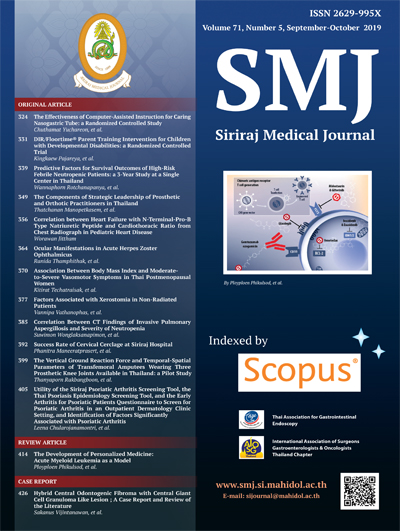Ocular Manifestations in Acute Herpes Zoster Ophthalmicus
DOI:
https://doi.org/10.33192/Smj.2019.55Keywords:
Herpes zoster ophthalmicus; Hutchinson’s sign; acyclovir; ocular inflammation; uveitisAbstract
Objective: To determine the prevalence and clinical predictors of ocular involvement in acute herpes zoster ophthalmicus.
Methods: A retrospective chart review of 167 patients presenting with acute herpes zoster ophthalmicus at the Outpatient Department of Ophthalmology, Siriraj Hospital, was performed. All skin lesions along the ophthalmic branch of the trigeminal nerve (CN V1) and ocular inflammatory signs were observed and documented.
Results: A total of 160 cases were analyzed. The prevalence of ocular inflammation in acute herpes zoster ophthalmicus was 73.1% (117/160). The types of ocular inflammations included conjunctival injection (99.1%), keratitis (51.3%), and iridocyclitis (21.4%). Nasociliary skin lesions (Hutchinson’s sign) were the best predictor of ocular inflammation in acute herpes zoster ophthalmicus (p = 0.006, OR = 3.6, 95% CI: 1.5-9.1). Other factors associated with ocular inflammation were a period of longer than 4 days from the onset of rash to an eye examination (p = 0.007, OR = 3.2, 95% CI: 1.4-7.5), and the initiation of systemic acyclovir treatment after 3 days from rash onset (p = 0.037, OR = 2.3, 95% CI: 1.05-4.96).
Conclusion: There is a high prevalence of ocular inflammation in acute herpes zoster ophthalmicus, especially among individuals with Hutchinson’s sign and delayed systemic acyclovir treatment. General practitioners should be aware of ocular involvement and refer high-risk patients for a complete ophthalmologic assessment.
Downloads
Published
How to Cite
Issue
Section
License
Authors who publish with this journal agree to the following conditions:
Copyright Transfer
In submitting a manuscript, the authors acknowledge that the work will become the copyrighted property of Siriraj Medical Journal upon publication.
License
Articles are licensed under a Creative Commons Attribution-NonCommercial-NoDerivatives 4.0 International License (CC BY-NC-ND 4.0). This license allows for the sharing of the work for non-commercial purposes with proper attribution to the authors and the journal. However, it does not permit modifications or the creation of derivative works.
Sharing and Access
Authors are encouraged to share their article on their personal or institutional websites and through other non-commercial platforms. Doing so can increase readership and citations.















